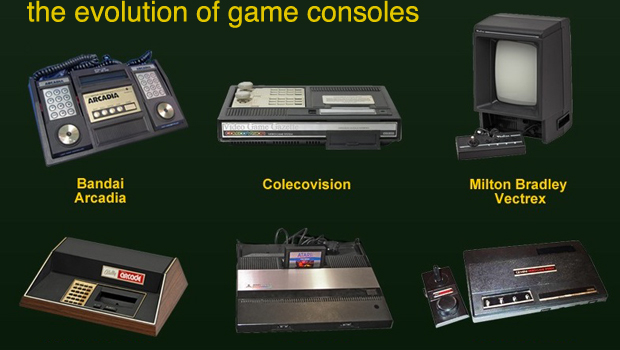

[Updated: July 2025]
The History of Gaming Consoles
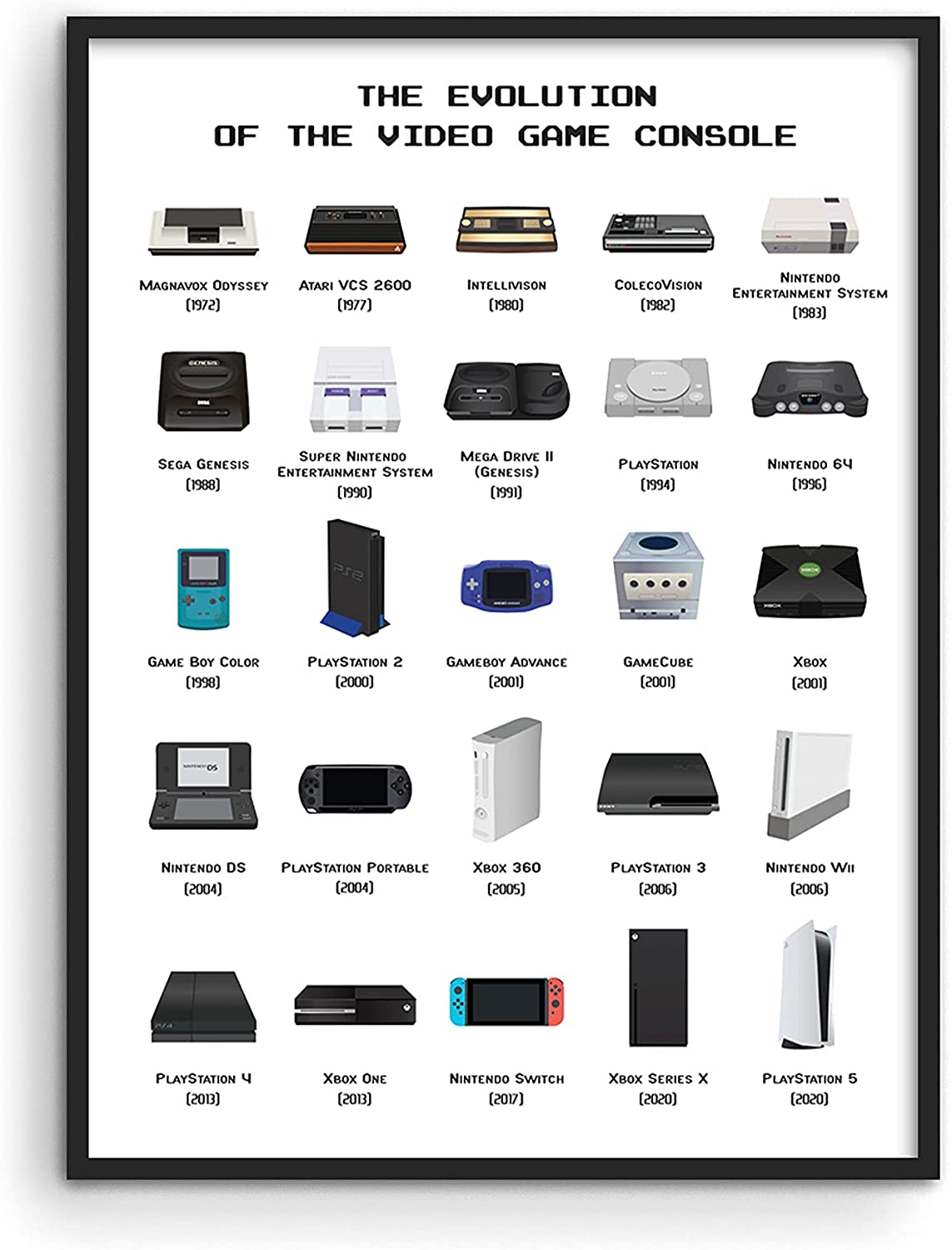
The Birth of Home Gaming (1972-1983)
First Generation – The Pioneer Era
Magnavox Odyssey (1972)
- First commercial home console
- No sound capabilities
- Plastic screen overlays for “graphics”
- 12 games via circuit cards
- Price: $99 (£500 in today’s money)
- Units sold: 350,000
Innovation Impact:
- Proved home gaming market existed
- Inspired Atari’s founder Nolan Bushnell
- Established console gaming patents
- Created the template for future systems
Atari Home Pong (1975)
- Single game system
- First console hit
- Built-in paddle controllers
- Spawned 100+ clones
- Cultural phenomenon status
Second Generation – The 8-Bit Revolution (1976-1983)
Atari 2600 (1977)
- First cartridge-based hit
- 1.19 MHz processor
- 128 bytes RAM
- 30+ million units sold
- 565 games released
Iconic Games That Defined the Era:
- Space Invaders (first killer app)
- Pac-Man (despite poor port)
- Pitfall! (platformer innovation)
- Adventure (first action-adventure)
- E.T. (industry crash catalyst)
Intellivision (1979)
- 16-bit processor (marketing claim)
- Better graphics than Atari
- Complex 16-direction controller
- First console with downloadable games
- Sports game focus
ColecoVision (1982)
- Best graphics of generation
- Near-arcade perfect ports
- Expansion module played 2600 games
- Victim of video game crash
- 2 million units sold
The Video Game Crash and Nintendo’s Resurrection (1983-1990)
The Great Crash of 1983
Causes of the Crash:
- Market Oversaturation
- 12+ console systems
- No quality control
- Retailers couldn’t stock all products
- Software Crisis
- Anyone could make games
- No licensing requirements
- Infamous E.T. disaster
- Consumer confidence destroyed
- Competition from PCs
- Commodore 64 price drops
- Better graphics and sound
- Utility beyond gaming
- Parents preferred “educational” computers
Industry Impact:
- 97% revenue drop in 2 years
- Major retailers stopped selling games
- Atari buried millions of cartridges
- “Video games are dead” – media consensus
Third Generation – The 8-Bit Golden Age
Nintendo Entertainment System (1985)
- Marketed as toy, not console
- Lockout chip for quality control
- D-pad controller innovation
- 61.9 million units sold
- Saved the industry
NES Success Factors:
- Super Mario Bros. pack-in
- Nintendo Seal of Quality
- Third-party licensing limits
- Retailer confidence restoration
- R.O.B. robot gimmick worked
Sega Master System (1986)
- Technically superior to NES
- Better graphics and sound
- Failed in US/Japan
- Succeeded in Europe/Brazil
- Alex Kidd couldn’t compete with Mario
The 16-Bit Console Wars (1990-1995)
The Fiercest Competition in Gaming History
Super Nintendo (1990/1991)
- Mode 7 graphics rotation
- Superior color palette (32,768 colors)
- Enhanced sound chip
- 49.1 million units sold
- Quality over quantity approach
Defining SNES Games:
- Super Mario World (pack-in perfection)
- The Legend of Zelda: A Link to the Past
- Super Metroid (atmosphere masterclass)
- Donkey Kong Country (pre-rendered graphics)
- Final Fantasy VI (JRPG pinnacle)
Sega Genesis/Mega Drive (1988/1989)
- “Blast Processing” marketing
- Faster CPU than SNES
- Edgier marketing approach
- 30.75 million units sold
- Arcade ports excellence
Defining Genesis Games:
- Sonic the Hedgehog (speed gameplay)
- Streets of Rage series
- Mortal Kombat (uncensored)
- EA Sports titles
- Phantasy Star series
The Marketing War:
- “Genesis Does What Nintendon’t”
- SNES blood censorship controversy
- Sonic vs Mario mascot battle
- Magazine advertisement battles
- Mall tour demonstrations
The 3D Revolution (1994-2000)
Fifth Generation – Enter the Third Dimension
Sony PlayStation (1994/1995)
- First successful disc-based console
- 3D graphics focus
- Adult-oriented marketing
- 102.49 million units sold
- Changed gaming demographics
PlayStation’s Industry Impact:
- Killed Sega Saturn launch
- $299 price point strategy
- Developer-friendly tools
- CD music in games
- Established Sony dominance
Nintendo 64 (1996)
- Last major cartridge system
- 4-player ports built-in
- Analog stick innovation
- 32.93 million units sold
- First-party focus
N64’s Legacy:
- Super Mario 64 (3D platforming blueprint)
- GoldenEye 007 (console FPS viability)
- Ocarina of Time (adventure perfection)
- Mario Kart 64 (local multiplayer king)
- Expensive cartridges limited third-party
Sega Saturn (1994/1995)
- Surprise early launch disaster
- Difficult development architecture
- 9.26 million units sold
- Strong in Japan only
- 2D games excellence
The Online Era Begins
Sega Dreamcast (1998/1999)
- First built-in modem
- Ahead of its time
- 9.13 million units sold
- Killed by PS2 hype
- Cult classic status
Dreamcast Innovations:
- Online gaming standard
- VMU memory cards
- Progressive scan support
- Arcade-perfect ports
- Web browser included
The Modern Era (2000-2013)
Sixth Generation – Online Becomes Standard
PlayStation 2 (2000)
- Best-selling console ever
- 155+ million units sold
- DVD player included
- Backward compatibility
- 3,800+ games library
Xbox (2001)
- Microsoft enters console market
- Built-in hard drive
- Xbox Live revolutionizes online
- 24 million units sold
- Halo defines console FPS
Nintendo GameCube (2001)
- Handle for portability
- Mini-disc format
- 21.74 million units sold
- First-party focus continues
- Beloved by Nintendo fans
Seventh Generation – HD and Motion Controls
Xbox 360 (2005)
- First HD console
- Xbox Live marketplace
- Achievement system created
- 84 million units sold
- Red Ring of Death crisis
PlayStation 3 (2006)
- Blu-ray player included
- $599 launch price shock
- Free online gaming
- 87.4 million units sold
- Slow start, strong finish
Nintendo Wii (2006)
- Motion control revolution
- Casual gaming explosion
- 101.63 million units sold
- Wii Sports phenomenon
- Non-gamer market captured
The Current Generation (2013-Present)
Eighth Generation – Services and Subscriptions
PlayStation 4 (2013)
- Focus on games over media
- 117.2 million units sold
- Share button innovation
- VR support added
- Dominant generation winner
Xbox One (2013)
- Always-online controversy
- Kinect bundle mistake
- 51 million units sold
- Game Pass changes everything
- Backward compatibility focus
Nintendo Wii U (2012)
- Tablet controller confusion
- 13.56 million units sold
- Marketing disaster
- Great games, poor execution
- Prepared ground for Switch
Nintendo Switch (2017)
- Hybrid console innovation
- 129+ million units sold
- Unified Nintendo development
- Indie game paradise
- Pandemic sales explosion
Ninth Generation – The Future is Now
PlayStation 5 (2020)
- Custom SSD revolution
- Adaptive triggers innovation
- Ray tracing standard
- 50+ million units sold
- Stock shortages for years
Key PS5 Features:
- Instant loading times
- 3D audio technology
- 4K/120fps capability
- Backward compatibility
- Digital-only option
Xbox Series X/S (2020)
- Two-tier approach
- Game Pass integration
- Most powerful console
- Smart Delivery system
- Focus on ecosystem
Series X vs Series S:
- Series X: 4K powerhouse
- Series S: 1080p budget option
- Same CPU/features
- Storage differences
- Broadest market appeal
The Future of Gaming Consoles
Emerging Trends
Cloud Gaming Integration:
- PlayStation Plus Premium
- Xbox Cloud Gaming
- Reduced hardware dependence
- Global accessibility
- Internet infrastructure crucial
Subscription Services:
- Game Pass (30+ million subscribers)
- PlayStation Plus tiers
- Nintendo Switch 2 Online
- “Netflix of Gaming” model
- Day-one releases
Technology Advancement:
- 8K gaming preparation
- AI upscaling (DLSS/FSR)
- VR/AR integration
- Haptic feedback evolution
- SSD standard baseline
Predictions for Generation 10 (2028+)
Likely Developments:
- Hybrid Cloud/Local Processing
- Best of both worlds
- Reduced hardware costs
- Always latest version
- AI-Powered Features
- Personalized difficulty
- Dynamic world generation
- Enhanced NPC behavior
- Real-time translation
- Modular Upgrades
- PC-like customization
- Extended console lifespan
- Reduced e-waste
- Consumer choice
- Platform Agnostic Gaming
- True cross-platform play
- Single purchase, any device
- Unified friends lists
- Cloud save standard
Conclusion
From the simple blips of Pong to the photorealistic worlds of today, gaming consoles have driven technological innovation for over 50 years. Each generation brought revolutionary changes: cartridges, CDs, online gaming, motion controls, and now instant loading and cloud streaming. The console wars have pushed competitors to innovate, benefiting gamers worldwide. As we look toward the future, the lines between console, PC, and cloud gaming continue to blur, promising an exciting future where great games are accessible to everyone, everywhere. The evolution continues, and the best is yet to come.
Infographic of The Evolution of Gaming Consoles
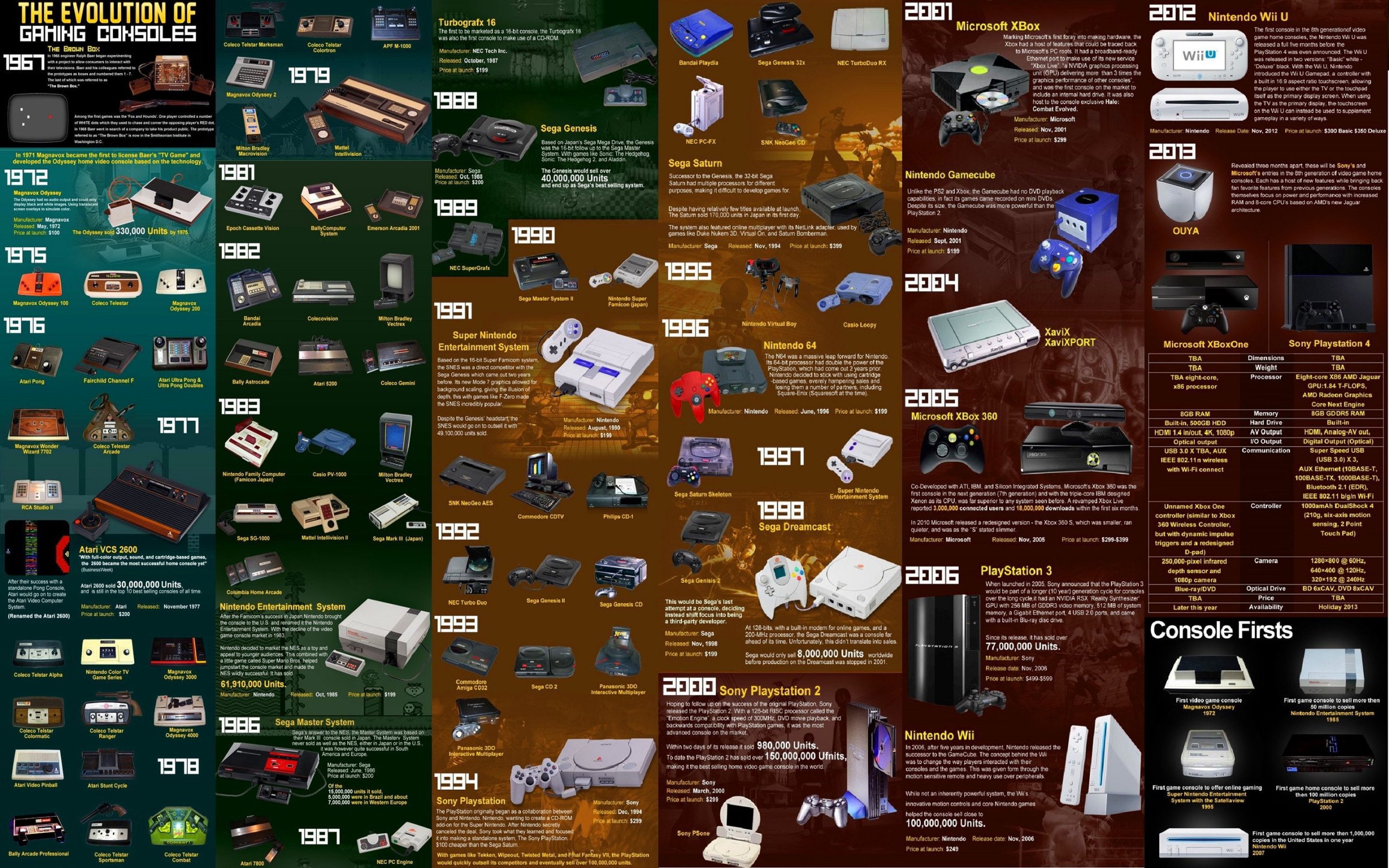
The Ones to Remember
The Brown Box
In 1966 engineer Ralph Baer began experimenting with a project to allow consumers to interact with their televisions. Baer and his colleagues referred to the prototypes as boxes and numbered them one through seven, the last of which was referred to as “The Brown Box.” Among the first games was the “fox-and-hounds” game, one player controlled a number of white dots which they used to chase and corner the opposing player’s red dot. In 1968 Baer went in search of a company to take his product public. The prototype referred to as “The Brown Box” is now in the Smithsonian Institute in Washington D.C.
– http://www.pong-story.com/sanders.htm
Magnavox Odyssey
In 1971 Magnavox became the first to license Baer’s “TV Game” and developed the Odyssey home video console based on the technology. The Odyssey had no audio output and could only display black and white images, using translucent screen overlays to simulate color. The Odyssey sold 330,000 units by 1975.
– Manufacturer: Magnavox
– Released: May, 1972
– Price at launch: $100
– http://www.giantbomb.com/odyssey/3045-74/
Atari 2600
After their success with a standalone Pong Console, Atari would go on to create the Atari Video Computer System (Renamed the Atari 2600) “With full-color output, sound, and cartridge-based games, the 2600 became the most successful home console yet” (from BusinessWeek) It would sell 30,000,000 units, and is still in the top 10 best selling consoles of all time.
– Manufacturer: Atari
– Released: November, 1977
– Price at launch: $200
– http://www.giantbomb.com/atari-2600/3045-40/
– http://images.businessweek.com/ss/06/10/game_consoles/source/3.htm
Nintendo Entertainment System (NES)
After the Famicom’s success in Japan, Nintendo brought the console to the U.S. and renamed it the Nintendo Entertainment System. With the decline of the video game console market in 1983, Nintendo decided to market the NES as a toy and appeal to younger audiences. This combined with little game called Super Mario Bros, helped jumpstart the console market and made the NES wildly successful. To date it has sold 61.91 million units.
– Manufacturer: Nintendo
– Released: October, 1985
– Price at launch: $199
– http://www.giantbomb.com/nes/3045-21/
Sega Master System
Sega’s answer to the NES, the Master System was based on their Mark III console sold in Japan. The Master System never sold as well as the NES, either in Japan or in the U.S., it was however quite successful in South America and Europe. Of the 15 million units it sold, 5 million were in Brazil and at least 7 million were in Western Europe.
– Manufacturer: Sega Enterprises
– Released: June, 1986
– Price at launch: $200
– http://www.giantbomb.com/sega-master-system/3045-8/
Turbografx 16
The first to be marketed as a 16-bit console, the Turbografx 16 was also the first console to make use of a CD-ROM peripheral.
– Manufacturer: NEC Technologies, Inc.
– Released: October, 1987
– Price at launch: $199
– http://www.giantbomb.com/turbografx-16/3045-55/
Sega Genesis
Based on Japan’s Sega Mega Drive, the Genesis was the 16-bit follow up to the Sega Master System. With games like Sonic: The Hedgehog, Sonic: The Hedgehog 2, and Aladdin, the Genesis would sell over 40 million units and end up as Sega’s best selling system.
– Manufacturer: Sega Enterprises
– Released: October, 1988
– Price at launch: $200
– http://www.giantbomb.com/genesis/3045-6/
Super Nintendo Entertainment System (SNES)
Based on the 16-bit Super Famicom system, the SNES was a direct competitor with the Sega Genesis which came out two years before. Its new Mode 7 graphics allowed for background scaling, giving the illusion of depth, this, coupled with games like F-Zero made the SNES incredibly popular. Despite the Genesis’ headstart, the SNES would go on to outsell it with 49.1 million units sold.
– Manufacturer: Nintendo
– Released: August, 1990
– Price at launch: $199
– http://www.giantbomb.com/super-nintendo-entertainment-system/3045-9/
Sega Saturn
Successor to the Genesis, the 32-bit Sega Saturn had multiple processors for different purposes, making it difficult to develop games for. Despite having relatively few titles available at launch, The Sega Saturn sold 170,000 units in Japan in its first day. The system also featured online multiplayer with its NetLink adapter, used by games like Duke Nukem 3D, Virtual On, and Saturn Bomberman.
– Manufacturer: Sega Enterprises
– Released: November, 1994
– Price at launch: $399
– http://www.giantbomb.com/saturn/3045-42/
– http://images.businessweek.com/ss/06/10/game_consoles/source/10.htm
Sony PlayStation
The PlayStation originally began as a collaboration between Sony and Nintendo. Nintendo, wanting to create a CD-ROM add-on for the Super Nintendo. After Nintendo secretly canceled the deal, Sony took what they learned and focused it into making a standalone system, The Sony PlayStation. $100 cheaper than the Sega Saturn, and with games like Tekken, Wipeout, Twisted Metal, and Final Fantasy VII, the PlayStation would quickly outsell its competitors and eventually sell over 100 million units.
– Manufacturer: Sony Computer Entertainment
– Released: December, 1994
– Price at launch: $299
– http://www.giantbomb.com/playstation/3045-22/
– http://images.businessweek.com/ss/06/10/game_consoles/source/11.htm
Nintendo 64
The N64 was a massive leap forward for Nintendo. Its 64-bit processor had double the power of the PlayStation, which had come out two years prior. Nintendo decided to stick with using cartridge-based games, severely hampering sales and losing them a number of partners, including Square-Enix (Squaresoft at the time)
– Manufacturer: Nintendo
– Released: June, 1996
– Price at launch: $199
– http://www.giantbomb.com/nintendo-64/3045-43/
– http://images.businessweek.com/ss/06/10/game_consoles/source/12.htm
Sega Dreamcast
At 128-bits, with a built-in modem for online games, and a 200-MHz processor, the Sega Dreamcast was a console far ahead of its time. Unfortunately, this didn’t translate into sales. Sega would only sell 8 million units worldwide before production on the Dreamcast was stopped in 2001. This would be Sega’s last attempt at a console, deciding instead shift focus into being a third-party developer.
– Manufacturer: Sega Enterprises
– Released: November, 1998
– Price at launch: $199
– http://web.archive.org/web/20080616093349/http://www.planetdreamcast.com/about/sega/
– http://www.giantbomb.com/dreamcast/3045-37/
– http://images.businessweek.com/ss/06/10/game_consoles/source/13.htm
PlayStation 2
Hoping to follow up on the success of the original PlayStation Sony releases the PlayStation 2. With a 128-bit RISC processor called the “Emotion Engine”, a clock speed of 300MHz, DVD movie playback, and backwards compatibility with PlayStation games, it was the most advanced console on the market. Within two days of its release it sold 980,000 units. To date the PlayStation 2 has sold over 150 million units, making it the best selling home video game console in the world.
– Manufacturer: Sony Computer Entertainment
– Released: March, 2000
– Price at launch: $299
– http://www.allgame.com/platform.php?id=47
– http://www.giantbomb.com/playstation-2/3045-19/
– http://images.businessweek.com/ss/06/10/game_consoles/source/14.htm
Xbox
Marking Microsoft’s first foray into making hardware, the Xbox had a host of features that could be traced back to Microsoft’s PC roots. It had a broadband-ready Ethernet port to make use of its new service “Xbox Live”, “an NVIDIA graphics processing unit (GPU) delivering more than three times the graphics performance of other consoles.” (Quote from Giantbomb, in the features section at the bottom), and was the first console on the market to include an internal hard drive. It was also host to the console exclusive Halo: Combat Evolved.
– Manufacturer: Microsoft
– Released: November, 2001
– Price at launch: $299
– http://www.giantbomb.com/xbox/3045-32/
– http://images.businessweek.com/ss/06/10/game_consoles/source/16.htm
Nintendo Gamecube
Unlike the PS2 and Xbox, the Gamecube had no DVD playback capabilities; in fact its games came recorded on mini DVDs. Despite its size, the Gamecube was more powerful than the PlayStation 2.
– Manufacturer: Nintendo
– Released: September, 2001
– Price at launch: $199
– http://www.giantbomb.com/gamecube/3045-23/
– http://images.businessweek.com/ss/06/10/game_consoles/source/17.htm
Microsoft Xbox 360
Co-Developed with ATI, IBM, and Silicon Integrated Systems, Microsoft’s Xbox 360 was the first console in the next generation (7th generation) and with the triple-core IBM designed Xenon as its CPU, was far superior to any system seen before. A revamped Xbox Live reported 3 million connected users and 18 million downloads within the first six months. In 2010 Microsoft released a redesigned version of the Xbox 360, the Xbox 360 S was smaller, ran quieter, and was as the “S” stated slimmer.
– Manufacturer: Microsoft
– Released: November, 2005
– Price at launch: $299 – $399
– http://www.gamespot.com/news/77-million-xbox-360s-sold-6407243
– http://images.businessweek.com/ss/06/10/game_consoles/source/20.htm
– http://www.giantbomb.com/xbox-360/3045-20/
– http://www.microsoft.com/en-us/news/press/2006/may06/05-09E3GamesPR.aspx
Sony PS3
When launched in 2005, Sony announced that the PlayStation 3 would be part of a longer (10 year) generation cycle for consoles. To keep it competitive over the long cycle, it had an NVIDIA RSX ‘Reality Synthesizer’ GPU with 256 MB of GDDR3 video memory, 512 MB of system memory, a Gigabit Ethernet port, 4 USB 2.0 ports, and came with a built-in Blu-ray disc drive. Since its release, it has sold over 77 million units.
– Manufacturer: Sony
– Release date: Nov, 2006
– Price at launch: $499 – $599
– http://www.giantbomb.com/playstation-3/3045-35/
Nintendo Wii
In 2005, after five years in development, Nintendo released the successor to the GameCube. The concept behind the Wii was to change the way players interacted with their consoles and the games, this was given form through the motion sensitive remote and heavy use over peripherals. While not an inherently powerful system, the Wii’s innovative motion controls and core Nintendo games helped the console sell close to 100 million units.
– Manufacturer: Nintendo
– Release date: Nov, 2006
– Price at launch: $249
– http://www.giantbomb.com/wii/3045-36/
– http://www.cnn.com/2009/HEALTH/02/11/wii.fit.elderly/
– http://venturebeat.com/2009/07/31/wiiassist-hacking-the-wii-controller-for-disabled-applications/
Wii U
The first console in the 8th generation of video game home consoles, the Nintendo Wii U was released a full five months before the PlayStation 4 was even announced. The Wii U was released in two versions a “Basic” white, and a “Deluxe” black. With the Wii U, Nintendo introduced the Wii U Gamepad, a controller with a built in 16:9 aspect ratio touchscreen, allowing the player to use either the TV or the touchpad itself as the primary display screen. When using the TV as the primary display, the touchscreen on the Wii U can instead be used to supplement gameplay in a variety of ways.
– Manufacturer: Nintendo
– Release Date: Nov, 2012.
– Price at launch: $300 for Basic, $350 for Deluxe
– http://www.giantbomb.com/wii-u/3045-139/
– http://www.nintendo.com/wiiu/features/tech-specs/
Playstation 4 (2013) and Xbox One (2013)
Revealed three months apart, these will be Sony’s and Microsoft’s entries in the 8th generation of video game home consoles. Each has a host of new features while bringing back fan-favorite features from previous generations. The consoles themselves focus on power and performance with increased RAM and 8-core CPU’s based on AMD’s new Jaguar architecture. More information on both consoles will be revealed at the Electronic Entertainment Expo (E3) on June 11th – 13th.
– http://www.giantbomb.com/playstation-4/3045-146/
– http://www.giantbomb.com/xbox-one/3045-145/
Nintendo Switch
The original Nintendo Switch was a ‘hybrid’ console, consisting of a console unit, a dock that is connected to a TV, and two Joy-Con controllers. Although it is a hybrid console, Nintendo considered it as “a home console that you can take with you on the go”. The screen supports multi-touch and includes haptic technology along with a 6.2 inch LCD screen that supports resolutions up to 720p (1280×720 px).
Playstation 5 (2020) and Xbox Series X (2019)
Released within two months of each other, these are the current consoles
Console Firsts
First…
– …video game console Magnavox Odyssey
– 1975
– …game console to offer online gaming
– Super Nintendo Entertainment System with the Satellaview
– 1995
– …game home console to sell more than 100 million copies
– PlayStation 2
– 2000
– …game console to sell more than 1 million copies in the United States in one year
– Wii
– 2007
– …game console to sell more than 50 million copies
– Nintendo Entertainment System
– 1985
– Source
– http://en.wikipedia.org/wiki/User:GameLegend/List_of_firsts_in_video_games
Best Selling
– 1. Sony Playstation 2 155 Million Units
– 2. Sony Playstation 102.49 Million Units
– 3. Nintendo Wii 99.84 Million Units
– 4. Microsoft Xbox 360 77.2 Million Units
– 5. Sony Playstation 3 77 Million Units
– 6. Nintendo NES 61.91 Million Units
– 7. Nintendo SNES 49.1 Million Units
– 8. Sega Genesis 40 Million Units
– 9. Nintendo 64 32.93 Million Units
– 10. Atari 2600 20 Million Units
– Playstation/PS2/PS3 –
– http://www.sbs.com.au/news/article/1735312/Sony-to-announce-launch-of-new-PlayStation
– NES/SNES/N64/Wii – http://www.nintendo.co.jp/ir/library/historical_data/pdf/consolidated_sales_e1303.pdf
– Xbox 360 –
– http://www.nintendo.co.jp/ir/library/historical_data/pdf/consolidated_sales_e1303.pdf
– Sega Genesis –
– http://www.giantbomb.com/genesis/3045-6/
– Atari 2600 –
– http://images.businessweek.com/ss/06/10/game_consoles/source/3.htm
The History of Gaming Consoles: From Brown Fox to Modern-Day Marvels
Gaming consoles have come a long way since the Brown Fox was released in 1967. This simple console allowed players to play basic games, but it paved the way for more advanced gaming consoles that would soon follow.
In the 1970s, the Magnavox Odyssey, the first home console, was released. It allowed players to play games such as tennis and ping pong. However, it wasn’t until the 1980s that consoles really took off. The Atari 2600 was a huge success, and classic games like Space Invaders, Pac-Man and Donkey Kong were introduced.
The 1990s saw the release of the Sega Mega Drive, which featured Sonic the Hedgehog, one of the most iconic video game characters of all time. The Super Nintendo Entertainment System (SNES) was also released, featuring classic games such as Super Mario World, The Legend of Zelda: A Link to the Past, and Donkey Kong Country.
The PlayStation, released in 1994, was Sony’s first gaming console and quickly became a favourite with gamers. Games such as Metal Gear Solid, Final Fantasy VII, and Crash Bandicoot were released on the console.
In the 2000s, the PlayStation 2 was released, becoming the best-selling gaming console of all time. Iconic games like Grand Theft Auto: San Andreas, God of War, and Metal Gear Solid 2 were released on the console.
The Xbox, released in 2001, was Microsoft’s first gaming console, and it featured games like Halo: Combat Evolved, Project Gotham Racing, and Fable. The Nintendo GameCube, released in 2001, featured games like Super Smash Bros. Melee, The Legend of Zelda: The Wind Waker, and Mario Kart: Double Dash.
The PlayStation 3, released in 2006, featured games like Uncharted: Drake’s Fortune, Metal Gear Solid 4, and LittleBigPlanet. The console also introduced online gaming through the PlayStation Network, which allowed players to play games with other players around the world.
The Xbox 360, released in the same year, was a huge success, and featured games such as Halo 3, Gears of War, and Mass Effect. The console also introduced online gaming through Xbox Live, which allowed players to play games with other players around the world and access digital content like movies and music.
Both the PlayStation 3 and the Xbox 360 featured improved graphics and gameplay mechanics, and were able to play high-definition video content. The two consoles were also rivals, with each company trying to outdo the other in terms of features and games.
Despite the rivalry, both consoles were hugely popular and helped to shape the modern gaming landscape. They paved the way for the current generation of consoles, which continue to push the boundaries of what is possible in gaming.
The current generation of consoles includes the PlayStation 5 and the Xbox Series X, both released in 2020. These consoles are more powerful than ever before, with advanced graphics and gameplay mechanics. Standout games on these consoles include Demon’s Souls, Spider-Man: Miles Morales, and Assassin’s Creed Valhalla.
The evolution of gaming consoles has been incredible, from the simple Brown Fox to the modern-day marvels of the PlayStation 5 and Xbox Series X. Each generation has brought new features, improved graphics, and innovative gameplay mechanics. It’s hard to imagine what the future of gaming consoles will bring, but one thing is for sure: gamers will always be eager for the next big thing.





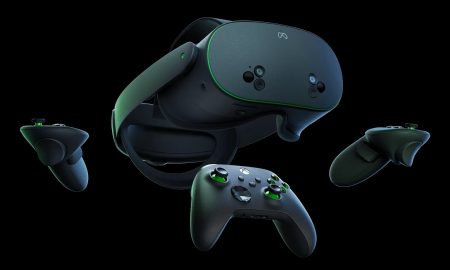








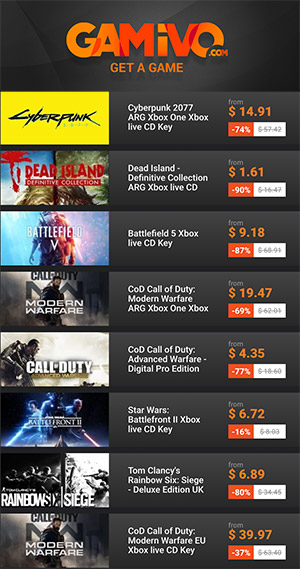















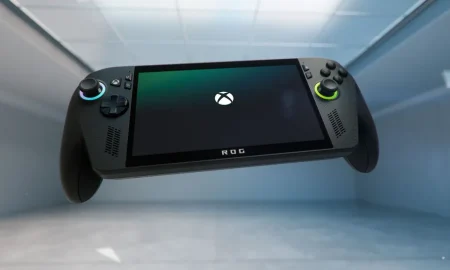


You must be logged in to post a comment Login